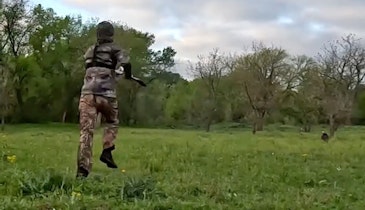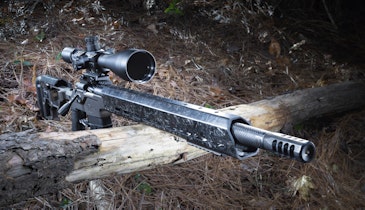How many times have you experienced a scenario of seeing tons of deer but no shooting bucks? Despite our best efforts to conceal our presence, whitetails just somehow seem to know we are in their woods. And at the end of the day, all we’re left with is questions about how.
Read carefully, because this story will explain how many mature bucks just seem to be able to give us the slip, even though trail camera photos and brief sightings tell us they’re there. Not unlike a soldier who’s spent time in a war zone, deer also learn to sense hunting pressure and adjust their behavior accordingly. This is often the reason why, despite having a killer setup and the wind in your face, you see no mature bucks.
A Sixth Sense?
Talk with a military member who has been deployed to a combat zone, and they’ll tell you that they quickly learned to identify potentially dangerous situations — their survival depended upon it.
“One afternoon I remember turning down a road in Baghdad we were very familiar with, and there’s no one outside — very creepy for that time of day,” said Don Gomez, a former Army sergeant and spokesman for Iraq and Afghanistan Veterans of America. Trash was piled high in a spot along the street where Sgt. Gomez and other drivers had not seen it before, so they steered clear of it. “We later called it in to an explosives team and, sure enough, they found one (a bomb) and detonated it,” Gomez explained.
A combination of experience and intuition allows humans to identify possibly life-threatening situations and avoid them. It’s not a stretch to think that some deer possess the same uncanny abilities. They can quickly recognize potentially dangerous situations and stay out of them. Like service members in war time, their very lives depend on it.
“For deer, they’re trying to survive,” said Neil Dougherty, a wildlife consultant for North Country Whitetails. “It’s not a game to them.”
A few years ago deer biologist Justin Thayer studied deer movements and survival in south-central Louisiana. The area was occupied by several hunt clubs who all agreed to let younger bucks walk. Once hunting season commenced, radio telemetry equipment revealed an interesting pattern in the movements of mature bucks.
“We would often find them (bucks) bedded down near hunters, but the hunters would never see them,” explained Thayer. “Hunters were very careful about not putting too much hunting pressure on deer, yet the deer just seemed to know how to avoid them.”
Nearly all hunters agree that whitetails have keen senses that enable them to detect predators. Deer often identify potential danger because a hunter makes a mistake.
“Deer learn by association,” Dougherty added. “They associate what just occurred to a negative outcome, and they learn from it. They’re masterful at detecting hunting patterns and adapting to avoid danger. Over time, they learn to associate certain terrain features and areas to hunting predation. This isn’t hard for them to do, because most of us are hunting deer the same way.”
To better understand how easy it is for a mature buck to sense impending danger, consider this analogy that comes from renowned deer biologist Dr. James Kroll. Imagine you are driving home from work. Have you ever noticed how, the closer you get to your home, you notice more changes in your surroundings?
As much time as dedicated hunters spend in the woods, it pales in comparison to deer that live there 24/7. If a bunch of limbs have been cut from a century-old oak, they notice the change. We try to trim shooting lanes and set stands well in advance of hunting season to give deer time to get “used” to the changes. But how many deer never become acclimated to what we see as relatively subtle environmental alterations? You can bet that the deer that don’t adapt to such changes are mature, and that they’re often the shooter bucks hunters are after.
Pattern-Busting Strategies
You have to think outside the box to bag mature bucks.
“The big thing I see is hunters set up in funnels,” Dougherty said. “Everyone who has the technology to look at satellite imagery knows where these spots are, and they put their blinds and stands in them.”
Ambushing battle-hardened bucks goes well beyond avoiding setting stands in traditional locations like field edges, funnels and inside corners. Since we know that deer don’t just leave an area that has ambush spots, start by scouting your hunting area and thinking like a deer.
“I tell clients to walk their property and try to figure out what locations deer would walk to to smell hunters,” added Dougherty. “Go downwind 100 yards from your traditional ambush locations and look for deer traffic that shows they are checking for hunters before they walk through an area.”
After identifying these traditional sites, think about how you would avoid hunters if you were a deer. For example, if you are hungry and want to fill your belly with some corn, how would you get to the corn field without walking through traditional ambush spots?
Don’t try to commit all this new information to memory. Take a notebook with you and record the locations of all your ambush sites (stand locations) and where deer might go to wind hunters. Then write down potential unconventional locations to hang stands. It’s also a good idea to get an aerial photo and topographic map of your hunting property and designate your ambush spots, probable deer escape routes and potential hunting locations. While studying each visual aid, ask yourself how deer can get through the area without you detecting them. Once you start looking at things from a deer’s perspective, you’ll see how easy you’ve made it for whitetails to avoid you.
When it comes to selecting new stand locations, avoid heavily used trails like the plague. There will often be little, if any, deer sign to indicate some deer are slipping through an area. Mature deer often zigzag through a property to avoid hunters.
Years ago I discovered by accident how some deer take the path of most resistance. I saw a buck approach by walking over an old beaver dam that ran across a small swamp. I never would have thought that the buck would take that difficult path, but it did.
Don’t just set stands in unusual spots like next to small ditches or in small patches of cover. Make a note of how you are getting to and from each stand location, and record how deer could detect you from your entry/exit routes. And think about all the human scent you are leaving behind. Always wear scent-control clothing and make ample use of scent-eliminating spray whenever you’re in the whitetail woods.
If you’re going to employ this new hunting strategy, you have to be comfortable seeing far fewer deer than you normally would. By staying off heavily used trails, funnels and other access points many deer use, you’re more likely to see the mature bucks that steer clear of these higher-traffic areas. In other words, what you give up in quantity you’ll more than get back in quality. And isn’t that what all serious deer hunters are after?






